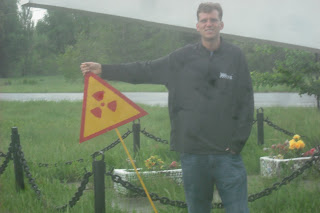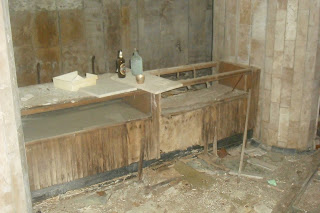On my second day in Ukraine, I went on a tour of Chernobyl.
It was a really interesting experience. I met the others on the tour at the
main square (Maidan) and we left for a 2 hour bus ride north of Kiev. Once we
were 30km from the site, we needed to pass the first checkpoint. We all had to
get out of the bus and have a guy from the military check our passports before
we passed through the gate. Our guide told us that there were strictly no
pictures allowed of the checkpoint, and if they saw us taking a picture, they
would make us get off the bus and wait at the checkpoint for the bus to take us
back to Kiev. The first stop on the tour was one of the villages nearby the
powerplant. This village was a smaller one. Right after the disaster, the government
decided to handle the situation by completely demolishing most of the village
and burying the waste. This was actually a terrible idea, as it allowed
radiation to leak into the soil, poisoning the surrounding areas. After they
noticed their mistake, they decided they wouldn’t do that again. The only
building in this village that was left standing was a kindergarten. We got to
go inside the building and look around. It was incredibly eerie. There were
children’s toys laying around and all the paint was peeling off the walls and
most of the windows were shattered.
Nearby the Kindergarten, our guide showed us a hotspot where
radiation levels were particularly high. He explained how radiation is
measured. A normal radiation rate for most places on earth is between .1 and .3
micro-zewots. In Ukraine, anything over .3 is generally considered unsafe for
extended periods of time. The rate in most places around the village we were in
at that time was around .4. The guide pointed out a tree near the location of
the hotspot. As he walked closer to it, the radiation levels got closer to
around 4. The guide held the radiation meter close to the ground near the base
of the tree. The level went to around 8. This was most likely due to some sort
of speck of radioactive graphite around the size of a piece of sand being
buried underground. The guide explained how radiation is very local, and you
can go most places in the Chernobyl area without a problem, but you need to be
careful about where you step, as there are many radioactive hotspots similar to
this scattered around the area.
Our nest stop on the tour was a memorial to the fire
fighters who fought in the area immediately following the explosion, most of
whom died pretty soon after that. After we saw the memorial, we passed through
the second checkpoint, 10km from the powerplant. While we were in the 10km
zone, we passed a cooling channel. The material at the bottom of the channel is
still extremely radioactive and water needs to constantly be pumped into the channel
to keep radiation from escaping. The water acts as a shield against the
radiation. There used to be fish swimming in the channel, one of which was
around 9m long, which tourists could see. However, a few years ago, they put in
a series of dams so not the fish are not in a part of the channel where
tourists can go.
Our next stop was the actual powerplant. Our guide explained
to us that while we were at the viewing location for the powerplant, we could
only take pictures of powerplant #4 (the one that exploded) and the new
sarcophagus they are building for it. If any other pictures were taken, police
would confiscate our cameras. At the viewing site, there was a memorial to the
victims of Chernobyl. The radiation levels in the area were around .8 to .9. Right
after we left the viewing are for the powerplant, it started raining real hard.
Our next stop was Припять (Pripyat), the nearest major city to
Chernobyl, located just a few kilometers from the powerplant. A day after the
explosion, the whole city of around 49,000 people was evacuated. People were
told they would be able to return home after a few days, so they left most of
their belongings and packed only the essentials. They never returned home, and
the city remains how it was left 27 years ago. We stopped outside the city to
take pictures of the Припять
sign and the red forest (in the rain). The red forest was one of the hardest
hit places by the radiation, and remains the most radioactive place in the
region. We weren’t able to go anywhere near the forest, but we could look at it
from a distance. We could see some of the dead vegetation, but most of the
vegetation had grown back. Our guide told us that radiation levels in the
forest could reach 200-300 microzewots in some places. A few people stood off
to the side of the road and measured rates of 7-8 microzewots.
When we got into the city of Припять, it was still raining really hard. Our guide told us that
tourists were technically not allowed in any of the buildings in the city,
because of the danger that buildings could collapse. He told us that since it
was raining so hard, he would lead us into a couple of the buildings which he
knew were safe. We walked through the hotel and the palace of culture. There
was broken glass everywhere and chunks of all sorts of stuff lying all over. In
the Palace of Culture, we went into a theater, with a stage and rows of seating
which had all pretty much caved in. The radiation levels inside the buildings
were lower than the rates on the streets outside. As we walked through the
city, we measured radiation in different areas. Moss acts like a sponge for
radiation and our guide warned us to try to not step on any moss on the ground.
He took a measurement right next to a patch of moss, and the level was around
5, but a few inches further away, it was much lower.
Next we went to an amusement park. The amusement park had
never been used before. It was set to open on May 1, 4 days after the
explosion. All the rides were set up like they were ready to use. Most of the
rides were overgrown with bushes and really rusty. There was a large chunk of
the Ferris wheel laying in the middle of everything. Most of the Ferris Wheel
was intact.
After Припять,
it was time to leave the 10km area. On our way out, we needed to pass through a
radiation control booth. There’s no danger that a person who visits Chernobyl
would become radioactive. The largest danger for tourists is that somebody
leaves the area with a speck of radioactive dust on their clothing. In order to
prevent this, each person needed to stand in a metal contraption with censors
all around it. After around 5 seconds, a green light would turn on, and a door
would open letting you out. If somebody didn’t pass radiation control, they had
stations where people could brush off their clothing. Everybody in our group
passed through without any problems. Our guide told us that one time when he
went to a particularly radioactive area, he could not get all the mud and dust
off of his shoes and he needed to leave his shoes at the control booth.
Before we went to back to Kiev, we stopped at a cafeteria
for lunch. During lunch, I talked to our tour guide about Ukraine and my trip
for a while. He said that he really liked volunteers that came from the US. He
recommended I travel to cities in western Ukraine in my free time and told me
he didn’t like the Russian speaking areas of the country very much. I wanted to
tell him that I wanted to see as much as I could of the Russian speaking parts
of the country in order to learn Russian, but figured that might make him a
little resentful of me. After lunch, we headed back to Kiev.
Pictures:
A guy that worked for the tour company had a cool shirt.
On the highway outside of Kiev, we saw this.
Not something you see that often in the US.
The main gate to Chernobyl.
Buildings in the town of Chernobyl
A memorial to the fire fighters that first responded.
A radiation level of 0.4
A few steps closer to the hotspot: 1.3.
Holding it close to the ground: 8.1
A WWII memorial
Something along the lines of "Nobody will be forgotten. Nothing will be forgotten."
Part of the WWII memorial.
The Kindergarten, overgrown in trees.
"Parents Corner"
Another shot of the WWII memorial.
A view of Reactor #4.
A cooling channel. At the bottom of it, there is tons of highly radioactive material. The constant water pumped in keeps that from getting out.
Reactor #4 from the bus window.
The new sarcophagus they are building.
Close up of Reactor #4.
Radiation: 3.4
Russian plaque on the memorial. The English version is below, in another picture.
There were security guards everywhere. Hard to get a picture without them.
The memorial.
People left coins on the memorial.
An English plaque.
The entrance to Pripyat
The Red Forest
Radiation: 6.5, off the side of the road near the Red Forest.
Our guide in the light blue, and another tourist, measuring the radiation.
Buildings in Pripyat
"Culture"
"Palace of Culture"




























































































































